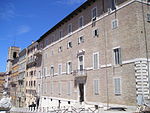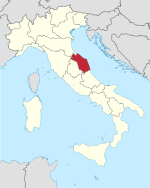Marche ( MAR-kay, Italian: [ˈmarke] ), in English sometimes referred to as the Marches ( MAR-chiz), is one of the twenty regions of Italy. The region is located in the central area of the country, and has a population of about 1.5 million people, being the thirteenth largest region in the country by number of inhabitants. The region's capital and largest city is Ancona.The Marche region is bordered by Emilia-Romagna and the republic of San Marino to the north, Tuscany to the west, Umbria to the southwest, Abruzzo and Lazio to the south and the Adriatic Sea to the east. Except for river valleys and the often very narrow coastal strip, the land is hilly. A railway from Bologna to Brindisi, built in the 19th century, runs along the coast of the entire territory. Inland, the mountainous nature of the region, even today, allows relatively little travel north and south, except by twisting roads over the passes.
From the Middle ages to the Renaissance period, many cities of the Marche were important cultural, artistic and commercial centres, the most prominent being Ancona, Pesaro, Urbino, Camerino and Ascoli Piceno.Urbino, which was a major centre of Renaissance history, was also the birthplace of Raphael, one of the most important painters and architects of that period. The Marche region is also the birthplace of Gentile da Fabriano, Cyriacus of Ancona, Donato Bramante, Giovanni Battista Pergolesi, Giacomo Leopardi, Gioachino Rossini and Maria Montessori.










